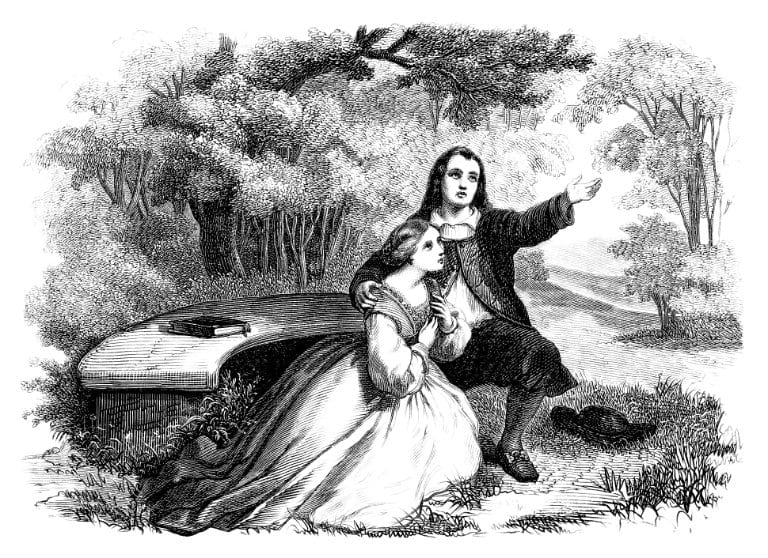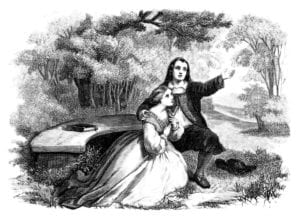‘Sir Thomas More’ (1590?)
‘Sir Thomas More’ was probably written in the early 1590s, a collaboration possibly involving as many as five different playwrights. Its interest now centres on a speech delivered by the eponymous hero that was probably written by Shakespeare, in which More berates a xenophobic crowd for failing to welcome refugees.
It is worth reflecting that the playwright was himself an outsider in London in these early years of his writing. We must imagine that (initially at least) his regional accent and dialect may well have marked him out. So this speech has particular force.
More generally, the interest lies in the fact that the speech survives in manuscript form, believed by many scholars to be Shakespeare’s own handwriting. The style of the writing, incidentally, is known as ‘Secretary Hand’, a style employed by Tudor civil servants.
Shakespeare the Actor
It’s sometimes forgotten that Shakespeare was an actor before he was an author. Opportunities in Stratford would naturally have been limited, so it is possible that one of the London theatre troupes that visited Stratford intermittently – Leicester’s Men, perhaps, or the Queen’s Men – may have recruited him some time in the late 1580s, and smoothed his path to London and a career in the theatre, working as both actor and writer.
His subsequent success as a playwright does not seem to have limited his appearances on the stage. The story goes that he made several roles his own, including the Prologue in ‘Henry V’, the ghost in ‘Hamlet’, Duncan in ‘Macbeth’, the title role in ‘Henry IV’ and the genial retainer Adam in ‘As You Like It’.
Homosocial Shakespeare?
Close male friendships are a common feature of Shakespeare’s plays, from ‘The Two Gentlemen of Verona’ (c. 1590) to ‘The Two Noble Kinsmen’ (c. 1613). In the former, Proteus pursues his devoted friend Valentine to Milan, where he falls in love with his friend’s intended; in the latter, Palamon and Arcite, Theban prisoners in an Athenian prison, are initially devoted to one another before they too fall in love with the same woman.
Did Shakespeare know and love someone called Antonio? In ‘The Merchant of Venice’ Antonio’s love for Bassanio is so deep he is willing to die for him. But at the play’s end, he is cruelly isolated, alone among couples. A similar fate awaits Antonio in ‘Twelfth Night’. Devoted to Sebastian he too is left out at the close as three couples connect.
No such fate awaits Achilles and Patroclus in ‘Troilus and Cressida’, though their intimacy is an open secret: for example, Patroclus is denounced as Achilles’s ‘masculine whore’ by Thersites. It seems quite likely that Shakespeare knew whereof he spoke in describing these relationships. The sonnets, after all, are predominantly addressed to the ‘fair youth’ – also known (as Sonnet 20 puts it) as ‘the master-mistress of my passion’.
Shakespeare the Writer
In Shakespeare’s early years in London (c.1590 – 4) he seems to have worked as a freelance playwright and poet, writing in a range of different genres – from History (‘Henry VI’) to Revenge Tragedy (‘Titus Andronicus’), from Comedy (‘The Comedy of Errors’) to poetry (‘Venus and Adonis’).
When the plague abated and the theatres re-opened, Lord Hunsdon the Lord Chamberlain formed a theatre troupe of the greatest actors of the day (Richard Burbage, Will Kemp) with Shakespeare to provide the scripts. In the next two years Shakespeare produced, among other scripts, ‘Romeo and Juliet’, ‘The Merchant of Venice’, ‘A Midsummer Night’s Dream’ and ‘Richard II’.
With the death of the Queen and the accession of James I in 1603, the Lord Chamberlain’s Men became the King’s Men – Shakespeare’s troupe for the last two decades of his life.
Revenge Tragedies in the 1580s
Shakespeare continues to write versions of Revenge Tragedies into the 17th century – ‘Hamlet’ (1600) for example, and ‘Macbeth’ (1606) – despite the fact that the golden age of the Revenge Tragedy – the 1580s – is long past.
Back then the emerging London theatre was dominated by the likes of ‘The Spanish Tragedy’ by Thomas Kyd (1558 – 1594). This is the decade in which Shakespeare may be imagined making his way, an apprentice among masters.
Is it merely a coincidence that ‘The Tempest’, one of his last plays, written in 1611, specifically abjures revenge and allows its central character Prospero to tell Antonio (‘whom to call brother / Would even infect my mouth’) that he will forgo revenge: ‘I do forgive / Thy rankest fault’, he reassures him: not the kind of gesture to be found in, for example, ‘Titus Andronicus’ (c. 1590).
Feasts in Shakespeare
Feasts and banquets play a small but notable part in Shakespeare’s plays. Among the most dramatic, Macbeth’s ‘solemn supper’ for Banquo stands out. Banquo is murdered by evening but his ghost makes sure that Macbeth’s cynical imprecation – ‘Fail not our feast’ – is not in vain.
Other notable banquets include the encounter between the triumvirs and Pompey in ‘Antony and Cleopatra’ in which Lepidus gets drunk and makes a fool of himself; the feast put on by Timon of Athens in honour of the many ‘friends’ who have sponged off him for years – they are served hot water; and the banquet Prospero offers to his erstwhile enemies in ‘The Tempest’, which abruptly disappears.
Most dramatic of all, however, must be the feast Titus Andronicus arranges for Tamora to avenge the rape of his daughter by her sons. Once she has eaten the pie he has prepared for her, he is free to reveal its contents: the bodies of her two murdered sons. A taste for revenge, perhaps.
The Impact of the Plague
Shakespeare lived his entire life in the shadow of the plague. It broke out in Stratford in the summer of 1564, killing around a quarter of the town. Later, as he was starting to make a name for himself in London, it struck again, closing the playhouses in 1593 – 4.
In 1603, the plague returned, killing around one fifth of London’s population and postponing the new king’s coronation. A further closure of the playhouses occurred in 1606, the year in which the plague killed Shakespeare’s landlady Marie Mountjoy. Altogether, in the decade between 1603 and 1613, it is reckoned the London theatres were closed for 78 months, over 60% of the time.
Yet curiously, apart from serving as a go-to oath for the likes of Falstaff (‘A plague upon you all’ etc.) and Mercutio (‘A plague o’ both your houses’), the plague plays no more than a marginal role in Shakespeare’s plays: referenced obliquely in plays like ‘Romeo and Juliet’, ‘King Lear’ and ‘Twelfth Night’, but otherwise barely mentioned.
‘Venus and Adonis’ (1593)
Shakespeare’s success as an actor and author in the late 1580s and early 1590s was abruptly jeopardised by the arrival of the plague in 1593 and the lockdown of the theatres that followed, mentioned earlier. While many of his theatrical companions, desperate to raise funds, took off on a tour of the provinces, Shakespeare remained behind to write what biographer Peter Ackroyd calls ‘one of the most fluent and eloquent of all English narrative poems’.
‘Venus and Adonis’ tells the story of a frustrated love affair that ends in tragedy. The frustration lies with Venus, whose desire for Adonis is not reciprocated. The young man prefers to go hunting, a preference that leads to his death. The poem, informed by a subtle eroticism, made Shakespeare’s name and fortune. Only one copy of the original print run survives, prompting Ackroyd to observe that the poem was read ‘literally to disintegration’.
Telling the Future in Shakespeare’s Plays
Soothsayers are an important feature of Shakespeare’s tool-kit. ‘Macbeth’ is constructed around a sequence of ten prophecies and their effect on the actions of the central character. All come true, though many are misunderstood.
In practice, misinterpretation is quite common in the plays. In ‘Richard III’ for example, King Edward is advised to beware of the letter G: unhappily the advice is misunderstood, and he does away with George of Clarence rather than Richard of Gloucester.
Similar misinterpretation arises over the death of the Earl of Suffolk in ‘Henry VI’: told that he will die by water, he fears drowning. In the event he is executed by pirates. In the same play, Somerset is advised to shun castles – later he is killed under an ale-house sign of a castle. Henry IV in Part Two makes a similar error: told years before that he will die in Jerusalem, he finally expires in the Jerusalem chamber at Westminster.
Not all advice is inaccurate, however: Julius Caesar was warned by a soothsayer and by his wife to avoid the Capitol, but the advice was ignored, with fatal results.
Literacy in Shakespeare’s England
In Shakespeare’s day, reading and writing were regarded as separate skills. One example is close to home: rumour has it that Shakespeare’s wife Anne and his two daughters Susanna and Judith could read fluently, but not write.
Even so, literacy skills seem quite common in the plays: in some instances, the documents concerned are quite innocent, like the love poems composed by (among others) the four friends in ‘Love’s Labour’s Lost’; in others, they’re central to the plot, like the forged letter that turns Gloucester against his son Edgar, or the forged letter that brings Brutus into the plot to murder Caesar.
At times written documents are used to advance the plot, like the edict from Delphos declaring Hermione innocent of adultery in ‘The Winter’s Tale’; elsewhere they are merely functional, like Macbeth’s letter to his wife describing his encounter with the witches, or the letter that recalls Othello to Venice.
One striking feature, however, is the literacy of the servant class: when Capulet issues invitations for his party, he tells his servant to ‘find those persons out / Whose names are written there’. All in a day’s work, it seems.
Cross-cultural Relationships in Shakespeare
Cross-cultural relationships are remarkably common in Shakespeare’s plays. Often they result from war, bringing together former enemies: examples include ‘A Midsummer Night’s Dream’, which opens and closes with Theseus’s proposed wedding to Hippolyta, and ‘Titus Andronicus’, which matches Saturninus with Tamora. In both cases, male victors marry defeated females.
The same pattern emerges elsewhere: in ‘Henry V’, the triumphant king romances Katharine, daughter of the defeated King of France, while in ‘Antony and Cleopatra’ the triumphant Roman weds the defeated Egyptian. Henry VI and Margaret of Anjou in ‘Henry VI Part One’ fit a similar pattern, along with Mortimer with Glendower’s daughter in ‘Henry IV Part One’: she speaks no English, he no Welsh.
Elsewhere, the best-known example of a cross-cultural relationship is probably Othello’s with Desdemona, where the disparity in background is a source of parental anxiety early in the play. By contrast, any tensions in Jessica’s relationship with Lorenzo in ‘The Merchant of Venice’ seem to be resolved pretty quickly as she seems to renounce her Jewish background in making her escape for Belmont.
The Earl of Southampton
For nearly four centuries the portrait was thought to represent a beautiful young Elizabethan woman with long copper-coloured hair, lipstick and earrings, caught in a faintly provocative pose. Then around the millennium, the owner, Alec Cobbe, discovered that it portrayed a young man, perhaps exploring his gender fluidity.
Further investigation revealed that the eye-catching young beau was most likely Henry Wriothesley, the Earl of Southampton, dedicatee of two of Shakespeare’s longer poems and the possible subject of some of the sonnets. Wriothesley (pronounced Rizley) had been under pressure to marry, but had resisted: one expression of that pressure may have been the first eighteen of Shakespeare’s sonnets, addressed to a handsome lad recommending that he reproduce his enviable genes.
Southampton later fell among bad company (see below under ‘The Earl of Essex’), and came close to losing his good-looking head. He was released from a sojourn in the Tower by James I.
‘Love’s Labour’s Lost’ (1594)
The Earl of Southampton, a louche but very wealthy young aristocrat on the fringes of literary London, was the dedicatee for Shakespeare’s highly successful long poem ‘Venus and Adonis’. The playwright, now nearing thirty years of age, may also have spent part of the 1593 – 4 plague lockdown at Southampton’s country house at Titchfield, using the time to write ‘Love’s Labour’s Lost’, a satire on a group of four would-be literary friends.
The friends have taken a vow of celibacy, but the arrival of four young women tests their mettle. For example, Biron falls in love with Rosaline, a young woman of colour. Praised as ‘born to make black fair’, Rosaline seems to anticipate the Dark Lady of the later Sonnets, many of which were written around this time. Her description in Act Four Scene Three has prompted many critics to believe the Dark Lady may have been inspired by the same real-life person as Rosaline.
Later in this scene, incidentally, Biron holds forth on love and delivers the longest speech in Shakespeare: 77 lines.
‘Love’s Labour’s Won’
‘Love’s Labour’s Lost’ (1594) is among the most inscrutable of Shakespeare’s plays – many of its references and much of its humour are now lost.
It seems likely it may well reference – and satirise – members of Southampton’s immediate coterie: for example, it is likely that Holofernes the schoolmaster is based on the polymath and lexicographer John Florio, a friend of Southampton – from whom, incidentally, Shakespeare may have learnt about Verona, the setting for ‘Romeo and Juliet’.
Other references and parallels in ‘Love’s Labour’s Lost’ are likely to remain elusive. Equally frustrating is the complete loss of what seems to be its sequel, ‘Love’s Labour’s Won’, date uncertain, referenced in Francis Meres’ ‘Wits Treasury’ (1598).




